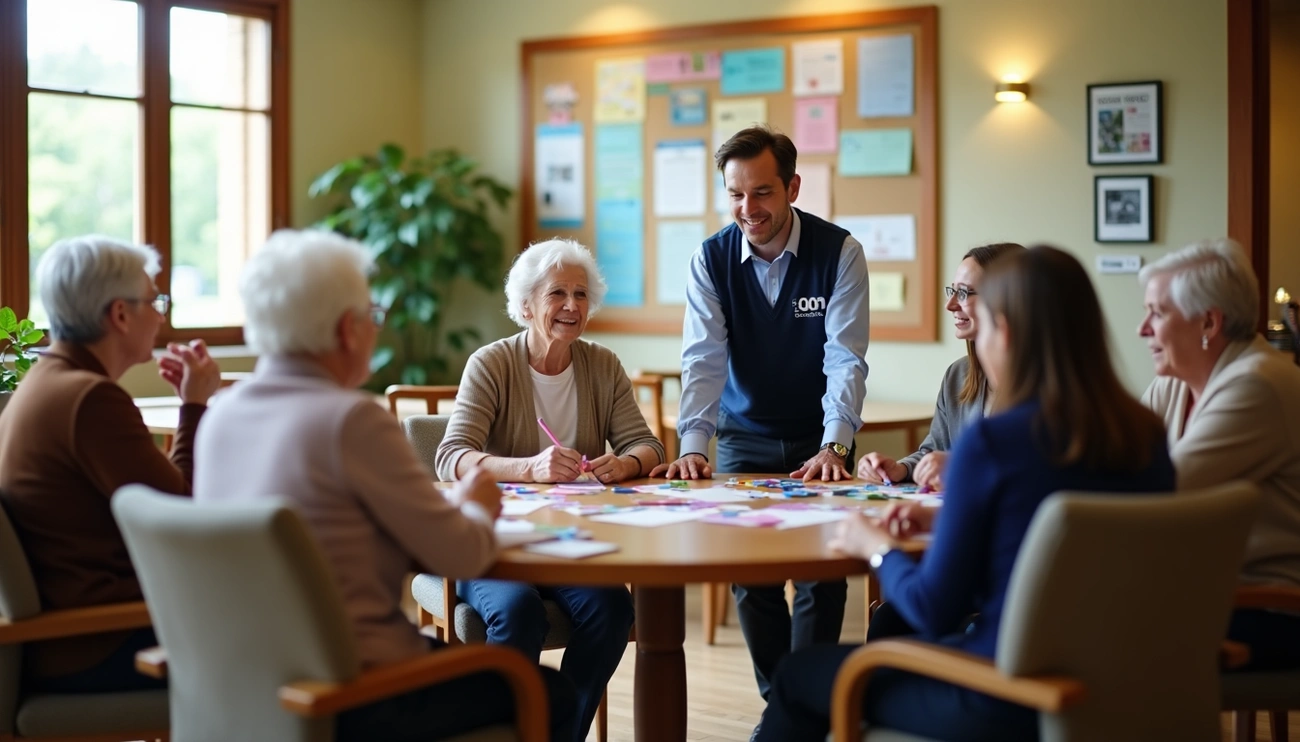Your cart is currently empty!
Nearly half of all Americans feel lonely today. This problem affects people of all ages and backgrounds. Before COVID-19, 20% of adult patients who visited primary care reported feeling lonely. The health impact is staggering – social isolation can be as harmful as smoking 15 cigarettes every day when it comes to early death.
COVID-19 made everything worse. The number of people experiencing social isolation has grown significantly across every age group compared to pre-pandemic times. Men and older adults showed the biggest increase in isolation. Research proves that longer-running programs work better at reducing loneliness. That’s why companies now focus more on detailed workplace wellness initiatives. The need becomes even more pressing since by 2030, one in six people worldwide will be 60 or older.
Community Action Programs (CAPs) play a vital role in fighting social isolation through employee wellness programs. Let’s look at practical ways to implement health and wellness programs in different environments. This approach has become essential for both communities and workplaces as they try to support people’s wellbeing.
Understanding Social Isolation in Community and Workplace Settings
Image Source: Dreamstime.com
“We don’t function well as human beings when we’re in isolation.” — Robert Zemeckis, Academy Award-winning film director and producer
Social isolation and loneliness are different but related issues that affect people in a variety of settings. Social isolation happens when people have few social relationships or rare contact with others, while loneliness is how isolated someone feels. Research shows 24% of community-dwelling Americans aged 65 and older deal with social isolation. The numbers show 35% of adults aged 45+ and 43% of adults 60+ say they feel lonely.
The workplace plays a key role in how isolation shows up in people’s lives. One in five employees around the world feel lonely at work, and more than half of American workers report feeling disconnected. This disconnect at work affects productivity a lot—employees who don’t feel lonely are much more likely to help their company succeed (74% vs. 63%).
Each generation experiences isolation differently. Young people stay more connected through digital means but report feeling lonelier. GenXers and baby boomers struggle more with isolation-related mental health issues like depression and anxiety.
Isolation does more than hurt emotional health. People who are socially isolated have a 29% higher risk of dying—similar to smoking 15 cigarettes every day. It also raises dementia risk by 50%, heart disease risk by 29%, and stroke risk by 32%. These numbers show why wellness programs must address isolation both in communities and workplaces.
How Community Action Programs (CAPs) Address Isolation
Image Source: Heart to Heart’s home care
“Community is much more than belonging to something; it’s about doing something together that makes belonging matter.” — Brian Solis, Digital analyst, anthropologist, and futurist
Community Action Programs (CAPs) run on federal funding through the Community Services Block Grant (CSBG). This grant provides key resources to states, territories, and tribes to reduce social isolation. [Over 1,000 local Community Action Agencies](https://acf.gov/ocs/programs/csbg) deliver CSBG-funded services nationwide and help more than 9 million people each year. These programs reduce isolation by building supportive networks and creating community bonds.
CAPs take several steps to reduce isolation. They create “third places” – social spots beyond home and work where people can connect naturally. Community cafés serve as perfect examples. These spaces help detect conditions like dementia early, act as community gathering spots, and spread awareness through education.
The programs succeed largely because they build social capital – the networks, trust, and mutual support that help communities work together. The Dementia Supporter Caravan initiative shows this approach well. Healthcare experts train ‘caravan mates’ who then strengthen community understanding and resilience.
CAPs handle more than $5.60 billion in public and private resources yearly. This funding lets them coordinate complete services from nutrition programs to community centers and educational initiatives. Their programs help isolated individuals connect with their communities while promoting self-reliance instead of dependency.
The most successful CAPs create solutions alongside residents. This approach deepens social capital, empathy, and community leadership. Such methods work especially well to build inclusive spaces for vulnerable groups facing isolation.
Implementing CAPs in Health and Wellness Programs
Workplace health and wellness programs need proper CAPs integration to work well. Organizations like Project Return Peer Support Network (PRPSN) show this approach in action. Their programs revolve around SAMHSA’s Eight Dimensions of Wellness and use evidence-based practices for service delivery. These programs deliver measurable results—H-E-B supermarket’s participants in their workplace wellness program had nearly 50% lower annual healthcare claim costs compared to non-participants.
Employers should start by understanding their employee’s needs. Survey results reveal workforce demographics and specific wellness challenges. Remote workers often need different support compared to their on-site counterparts. The program should start by giving access to facilities that encourage physical activity. Supportive policies and incentives help boost participation.
Program success depends heavily on technical support. Staff members provide in-person and virtual sessions for potential applicants. Regular communication and ongoing guidance create targeted learning opportunities. Tailored wellness programs work better because they address different priorities based on age groups and job functions.
Strategic collaborations with local health organizations make these programs truly successful. Health fairs, educational workshops, and vaccination drives extend wellness resources beyond employees to the whole community. This approach improves employee fitness while building a healthier community.
Conclusion
Social isolation has become a major health crisis in America that affects nearly half the population. The health risks match smoking 15 cigarettes each day. Community Action Programs (CAPs) provide economical solutions to curb isolation with well-laid-out wellness initiatives. These programs work because they create supportive networks and encourage meaningful connections within communities.
CAPs show remarkable results by establishing “third places” – neutral spots beyond home and work where people naturally gather and connect. On top of that, they build social capital through trust and reciprocity that creates lasting community bonds and reduces isolation over time.
Workplace programs represent a crucial next step. Companies see real benefits when they evaluate employee needs, offer technical help, and develop customized approaches. H-E-B supermarket’s program shows participants had almost 50% lower healthcare claim costs than those who didn’t take part.
The most effective programs share key features. They take a ground-up approach and create solutions with community members instead of forcing preset structures. These programs reach beyond organizational limits through mutually beneficial alliances with local health organizations. This approach promotes both employee wellness and community health.
Our aging population and rising social isolation rates across generations make CAPs vital to our collective well-being. Their detailed approach tackles both the feeling of loneliness and actual isolation through proven, evidence-based methods. Communities and organizations should treat these programs as key parts of public health infrastructure, not optional perks.
The facts speak for themselves – humans need social connection. Despite increased digital connection, meaningful personal interactions continue to decline. This decline makes CAPs more crucial than ever. Integrating these programs into workplaces and communities creates environments where people flourish together rather than struggle alone.
Key Takeaways
Community Action Programs (CAPs) offer proven strategies to combat the growing social isolation crisis affecting nearly half of Americans, with measurable health and economic benefits for both individuals and organizations.
• Social isolation carries health risks equivalent to smoking 15 cigarettes daily, increasing mortality risk by 29% and dementia risk by 50%.
• CAPs create “third places” beyond home and work where people naturally connect, building social capital through trust and community networks.
• Workplace wellness programs using CAP strategies show dramatic results—H-E-B participants had 50% lower healthcare costs than non-participants.
• Successful implementation requires personalized approaches, community partnerships, and bottom-up solutions co-created with participants rather than imposed structures.
• With over 1,000 local Community Action Agencies managing $5.60 billion annually, CAPs represent essential public health infrastructure for addressing isolation across all age groups.
The evidence is compelling: as digital connectivity increases but meaningful personal interactions decline, CAPs provide the structured, evidence-based interventions necessary to transform isolated individuals into thriving community members.
FAQs
Q1. What are effective strategies to combat social isolation? Effective strategies include improving social skills, enhancing social support, increasing opportunities for social interaction, and addressing negative thought patterns. Community Action Programs (CAPs) implement these strategies by creating supportive networks, establishing “third places” for social gatherings, and fostering community connections.
Q2. How can workplace wellness programs address social isolation? Workplace wellness programs can address social isolation by integrating CAP strategies, assessing employee needs, providing personalized approaches, and partnering with local health organizations. Successful programs often focus on creating inclusive environments, offering opportunities for social interaction, and promoting both physical and mental well-being.
Q3. What are the health risks associated with chronic social isolation? Chronic social isolation can increase mortality risk by 29%, comparable to smoking 15 cigarettes daily. It also raises the risk of dementia by 50%, heart disease by 29%, and stroke by 32%. These health risks underscore the importance of addressing social isolation through comprehensive wellness programs.
Q4. How do Community Action Programs (CAPs) help reduce social isolation? CAPs help reduce social isolation by creating supportive networks, establishing community hubs, and implementing programs that foster social connections. They manage significant resources to coordinate comprehensive services, including nutrition programs, community centers, and educational initiatives, all aimed at strengthening community bonds and reducing isolation.
Q5. What role does social media play in addressing feelings of isolation? While people often turn to social media when feeling lonely, research suggests it may not effectively reduce feelings of isolation. In fact, spending time on social media can sometimes make individuals feel lonelier. This highlights the importance of fostering genuine, in-person connections through community-based programs and activities.


Leave a Reply